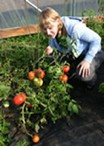- About Us
- Events & Training
- Professional Development
- Sponsorship
- Get Involved
- Resources
Sustainable Washington3.7 Food Security & AgricultureAgriculture is the largest sector of the Washington economy, generating $8.2 billion in 20071. As an industry, agriculture is directly responsible for about 6% of the state’s greenhouse gas emissions. Climate change impacts in Washington’s agricultural areas are expected to include both increases in temperature and changes in precipitation patterns. Based on studies by the State mandated GHG and VMT reduction goals [1] University of Washington Climate Impacts Group[1], the number of frost free days per year is expected to increase by 40 days by 2080 and the amount of carbon dioxide in the atmosphere will increase, both of which will benefit some crop productivity in Washington. However, spring and summer stream flows will decrease, and some areas, such as the Yakima Basin, will see water shortages, especially those holding junior water rights.[2] Combined warming and the “fertilization” effect of increased CO2 could increase yields for some crop varieties, particularly winter wheat and apples, but these gains would be limited by shortages of irrigation water. In some areas, such as the Yakima Basin, climate change is expected to exacerbate existing water shortages. Higher energy costs will increase equipment operation and irrigation costs. Some Washington crops, such as wheat, are dependent upon nitrogen fertilizers manufactured from natural gas. As costs for natural gas (a lower carbon fuel) increase, costs of nitrogen fertilizer will also increase. Nationwide, climate change effects are expected to push crop-productive areas further north while decreasing the overall yield of a number of food crops, such as corn. This nationwide northern shift for agriculture and the decreased productivity of a number of crops will place Washington’s agriculture in an increasingly critical role for the nation. This raises issues of social responsibility for Washington’s role in feeding the nation and highlights the importance of protecting agricultural land and agricultural production in Washington for the benefit of future residents throughout the country.3 While Washington’s agriculture is an important source of food supplies for the nation, the systems that put food on our tables also contribute to greenhouse gas production and climate change, and thus call for measures to reduce related carbon emissions. These emissions come from three primary sources: Enteric fermentation – the release of methane (CH4) as a byproduct of ruminant (cattle) digestion. Manure management – manure is a significant source of both CO2 and N2O. Agricultural soils – direct and indirect emissions of N2O from application of fertilizers and other agricultural activities. The agricultural industry also uses significant amounts of fuel and electricity for agricultural activities, processing, product shipment, and irrigation. However, these impacts are less well quantified. In addition, agricultural practices create opportunities for carbon sequestration. Many areas of the nation and the world will not be as fortunate as Washington with respect to crop yields. In our global food system, we have grown accustomed to easy access to out-of-season produce and inexpensive processed foods from distant sources. While the notion of “food-miles” has begun to make the public aware of the issue, we need to move past these oversimplified descriptions and understand where our food comes from and how it is produced. This knowledge will prepare us to adapt to both food production and diet. ActionsThe following list of actions is separated into three categories: Getting Started, Making a Commitment, and Expanding the Commitment. This graduated approach allows jurisdictions to implement measures that are appropriate to their community’s current level of involvement in climate change and sustainability issues and in consideration of locally adopted plans, codes, regulations, policies and goals. Getting Started3.7.1 Provide education on food security and agriculture.Planners can educate themselves, the public, and elected officials on topics related to food security and agriculture, through various sources including APA Policy Guides and PAS reports[4] These sources provide information including:
3.7.2 Develop farmland preservation ordinances.According to the Office of Farmland Preservation Washington State lost 460,000 acres of farmland between 1997 and 2007, and the loss continues[5]. Incorporate a ‘no-net-loss’ policy for important agricultural land into local comprehensive plans, and specify programs and techniques for protecting this land. Designate agricultural resource lands in local plans, and give consideration to local food security, including supplies for local food banks, schools and institutions. (Local Action)
3.7.3 Develop right-to-farm ordinances.Incorporate provisions in right-to-farm ordinances to protect farmers from nuisance lawsuits for agricultural operations. Develop a statewide database of county-adopted variations of the state’s model Right to Farm Act, to assist remaining counties when conducting local ordinance updates. (Local and State Action) 3.7.4 Assess water availability and demand.Perform a watershed assessment per the Watershed Planning Act (Chapter 90.82 RCW) to provide a detailed analysis of water availability and demand that will help in analyzing future water rights decisions. (Local and/or Regional Action) 3.7.5 Incorporate water management strategies.Facilitate water conservation and irrigation water management to conserve water and improve nitrogen cycling. Incorporate watershed planning into comprehensive plans, capital facilities plans, and development regulations. (Local, Regional, and State Action) 3.7.6 Market locally and regionally produced agricultural goods to local consumers.Conduct inventories of regional food system resources to better understand the economic impact and future potential of local and regional agriculture, food processing, food wholesaling, food retailing, and food waste management activities. (Local Action) 3.7.7 Remove regulatory barriers.Remove unnecessary regulatory barriers to urban agriculture, and support community gardens with low-cost local jurisdictional resources. Also, examine local zoning codes to ensure that they allow for a wide variety of retail outlet options for fresh produce, including seasonal and permanent agricultural retail stands, small grocers/greenmarkets, farmers markets, and large supermarkets. Refine definitions of farmers markets to preference agriculture (versus non-food activities), and increase acceptance of electronic benefits transfer (EBT—food stamps) and WIC payments (Women, Infants, and Children Program) at farmers markets. (Local and State Action) 3.7.8 Encourage community supported agriculture (CSA).Provide incentives for CSA enterprises and other small to medium farms with local direct market opportunities to use organic and sustainability-oriented practices that conserve water, build soil structure, and store carbon. Facilitate development of CSA farm networks, information, and technical assistance for market change. (Local Action)
3.7.9 Encourage more localized food sources.Provide for community farming and farmers markets in city and county land use plans to possibly reduce the fuel required to transport food products to market. Make farmers markets and community gardens allowable uses in all zones. Identify suitable areas for farmers markets in land use plans. Develop a city or community garden program. and allow for the keeping of chickens in residential areas (Local Action). Making a Commitment3.7.10 Provide planning support for farmland preservation.Evaluate options for maintaining viable agricultural land, as appropriate. Options may include down-zoning of farm lands, eliminating residential well exceptions, developing a county-wide Transfer of Development Rights (TDR) program, and conservation easements. At the state level, develop and implement carbon credit trading from urban to agricultural areas. (Local and State Action) 3.7.11 Provide incentives for farmland preservation.Implement financing and other mechanisms (e.g., micro loan, revolving loan fund, conservation easements, and TDR) to provide voluntary incentives for farms to create and utilize sustainable practices. (Local Action) 3.7.12 Support community gardens.Inventory publicly owned lands that are vacant or underutilized, and convert suitable sites to community gardens. These could include vacant park lands, portions of school property, etc. Develop consistent policies across city agencies about rights-of-way and other open land use for community garden or urban agricultural purposes. Encourage new residential and mixed-use development to include community gardens or resident gardens, including rooftop gardens. Encourage private owners to make remnant or unused investment properties available for temporary use as community gardens (Local Action) Biochar is charcoal created by pyrolysis of biomass. (Pyrolysis is the chemical decomposition of a condensed substance by heating in low oxygen conditions.) Creating biochar draws carbon from the atmosphere, and allows it to be stored in soil when applied to agricultural lands. Since biochar can sequester carbon in the soil for hundreds to thousands of years, it has received considerable interest as a potential tool to slow global warming. At the same time its presence in the earth can improve water quality, increase soil fertility, and raise agricultural productivity. 3.7.13 Include food system issues in local plans.Remove regulatory barriers to the local production and sale of food. Include food system considerations, including local production and demand, in city and county plans and multi-county planning policies, including economic development plans. Include land necessary for community gardens and for support of urban agriculture activities in comprehensive planning efforts. (Local, Regional and State Action) 3.7.14 Expand direct connections to farm products.Increase participation in Farm-to-School programs. Develop Farm-to-Institution programs (government facilities, major employers, educational institutions). Build on findings of current Farm-to-School efforts and organizations in Washington. Increase consumption of locally and regionally produced food in schools, hospitals, and group housing with central cafeterias. (Local, Regional and State Action) 3.7.15 Encourage farm practices to reduce carbon emissions.Encourage carbon sequestration in agricultural lands through conservation tillage, optimizing crop rotations, and using fertilizer from organic waste streams. Improve management of livestock wastes, especially from concentrated dairy and poultry operations. Support renewable, on-farm bio-gas production from anaerobic digesters. (Local, Regional and State Action) 3.7.16 Provide information on climate change to farm and forestry.Support improved information for agricultural and forestry uses such as improved regional climate predictions, information regarding what crops and livestock will be successful with climate changes, and others. Encourage agriculture to participate in disaster planning (Local, Regional and State Action) Expanding the Commitment3.7.17 Revise state farm valuation and taxes.Rewrite the Public Benefit Rating System of Open Space and the Land Valuation Tax System to facilitate preservation of farmland, allow multiple owners to group their parcels together to benefit from open space designations, consistent with other agricultural production requirements, and allocate funds from farms leaving Agricultural Open Space classifications to finance farmland preservation. Develop state legislation that levies a tax on the conversion to non-farm uses of important agricultural land in areas designated for agricultural land preservation.[6] (Local Action and State Action) 3.7.18 Establish infrastructure funding limits.Require that state funds for infrastructure facilities, especially for highways and sewer facilities, not be provided unless the State Office of Farmland Preservation finds that the facilities will not be detrimental to the continuation of agriculture.[7] (State Action) 3.7.19 Support research and education.Continue developing agricultural pilot programs to test and evaluate innovative agricultural practices that can increase crop yield, decrease water use, and/or provide for carbon reduction in agricultural practices. Facilitate implementation of appropriate agriculture technologies such as anaerobic digesters for treating dairy waste, integration of direct seeding, reduced tillage, and residue management to increase soil carbon storage. Educate about and advance current use of biochar as a benefit to farms and climate. Provide information to help reduce agricultural greenhouse gas emission through precision agriculture (reduces fuel and fertilizer usage), appropriate cultivation and livestock on-farm practices, educational programs, and incentives. (Local and State Action) 3.7.20 Establish water banking.Develop the ability to bank and exchange water rights for agricultural purposes, either through lease or purchase programs, to provide incentive for conservation. (Local, Regional and State Action)
3.7.21 Support start-up agriculture and food processing.Encourage the provision of community space, such as commercial kitchens, for use by community members and start-up agricultural businesses; facilitate provision of necessary but missing elements for regional food economies: processing (including mobile meat slaughter facilities), cold storage, and produce terminals. (Local Action) 3.7.22 Develop State food policies and charter.Form a statewide food policy council to inform WSDA and other stakeholders about alternative food policy strategies that promote healthy Washington families and a vibrant Washington economy. Develop a state food charter emphasizing the importance of local and regional production and markets. (State Action) Footnotes 1 Office of Farmland Preservation, 2008 Report to the Washington State Conservation Commission, January 2009. 2 Climate Impacts Group, University of Washington, the Washington Climate Change Impacts Assessment: Evaluating Washington’s Future in a Changing Climate, Executive Summary (Final Draft), February, 2009. 3 Climate Impacts Group, University of Washington, Conference, February 12, 2009. 4 The APA has produced Policy Guides and PAS reports on Community and Regional Food Systems, and Agricultural Lands Preservation, for example. Planners should familiarize themselves with these topics. 5 Office of Farmland Preservation, 2008 Report to the Washington State Conservation Commission, January 2009. 6 Adapted from the National APA Policy Guide on Agricultural Land Preservation, April 26, 1999. 7 Adapted from the National APA Policy Guide on Agricultural Land Preservation, April 26, 1999. |

 Harvest Celebration Farm Tour
Harvest Celebration Farm Tour  Community Fruit Tree Harvest
Community Fruit Tree Harvest  Caretaker’s House from
Caretaker’s House from 